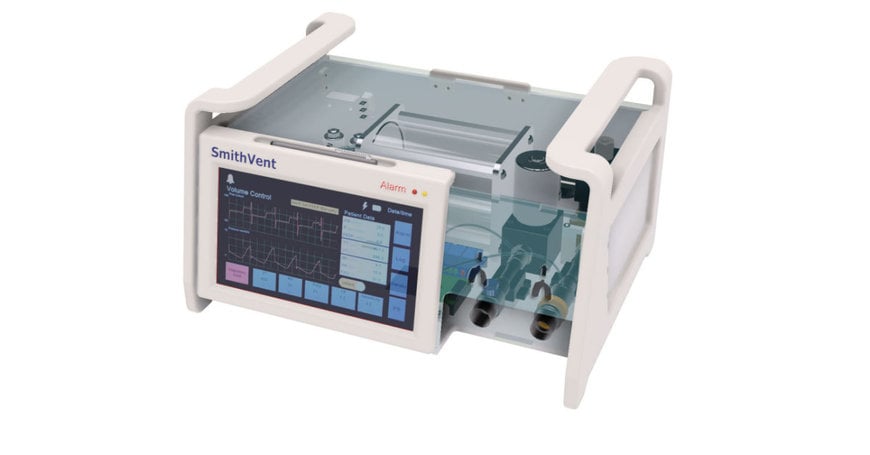www.industryemea.com
02
'20
Written on Modified on
Smith College Team From Massachusetts Wins CoVent-19 Challenge to Design New Ventilator for Developing World
“We came into this not knowing anything about ventilators,” SmithVent team lead says, Top 3 teams from over 200 submissions win on-demand 3D printing services from Stratasys.

a dozen anesthesiology resident physicians from Massachusetts General Hospital kicked off an audacious public challenge to design a rapidly deployable, minimum viable ventilator that could address shortages caused by the COVID-19 pandemic, particularly in developing countries. Just three months and more than 200 submissions later, a team of engineering alumnae, staff and faculty from Smith College in Northampton, Mass., had taken a winning design from concept through working prototype. The next step could be a final product for regulatory approval in Nigeria, just one of the countries that have been talking with the CoVent-19 Challenge organizers.
The 30-person Smith College team collaborated on a simplified, cost-effective, easily manufactured pneumatic design particularly tailored to COVID-19 patient needs. The SmithVent design, which is one-tenth the cost of traditional ventilators, combines economical proportional solenoid valve technology with an air-oxygen mixing chamber to meet the full set of requirements for COVID-19 ventilation. The team relied primarily on readily available, off-the-shelf components, which reduced custom machining and improved compatibility with other medical equipment. The enclosure, ISO fittings, and mounting blocks can be produced using FDM® or stereolithography 3D printers. The design is open source for anyone to use and improve.
Smith College Engineering Professor Susannah Howe said the timeline was intense. “To a person, we came into this not knowing anything about ventilators,” she said. “In two months we went from knowing nothing to having a functional prototype. That’s just crazy. To see that trajectory in such a short period of time, with people who are volunteering their time on top of their other jobs is amazing and heartwarming and so rewarding.”
Two other teams were also recognized by the CoVent-19 Challenge judges. The second-place InVent Pneumatic Ventilator was submitted by a San Francisco-based team comprised of fuseproject, a design and innovation firm founded by Swiss designer Yves Behar, and Cionic, a medical device technology start-up. The InVent prototype is a pneumatically driven ventilator optimized for a COVID-19 healthcare context that can be assembled in under four hours. The prototype used 3D printing technology from Stratasys, and featured a simple and intuitive human-machine interface and custom rapid-manufactured venturi flow sensors. A multi-ventilator tablet display encourages patient distancing.
The third-place prototype, RespiraWorks, was developed by a global team of dozens of engineers, healthcare workers, and other professionals that bring a focus on developing countries and low-resource communities. The model uses a sophisticated blower-based ventilation system, simplified assembly and manufacturing, and high-quality, open-source software. Parts are designed to be available from local supply chains around the world. “Patients suffering from COVID-19 require and deserve high-quality ventilation, regardless of whether they were born in a rich country or a poor one,” said RespiraWorks Founder and Executive Director Ethan Chaleff of Oakland, Calif.
Dr. Richard Boyer, founder and director of the CoVent-19 Challenge, said when they began planning in March, it was unclear if there would be enough ventilators even in the United States to treat pandemic patients. “Our focus has since shifted to developing countries, where we’re seeing high death rates and limited resources to deal with the ravages of this new disease,” he said. “The test bed we developed gives us a lot of confidence in the performance of the winning prototype, and frankly there is probably tremendous value in getting other finalist designs out into the world too.”
Seven finalist prototypes were evaluated using a test bed to determine which design provides the best combination performance against safety, reliability, manufacturability, affordability, and simplicity.
The three winners will receive a total of $10,000 in credits for 3D printing from Stratasys (NASDAQ: SSYS), which also provided access to free 3D printing and a team of three application engineers for the seven finalist teams building their working prototypes. In addition, the challenge was hosted on the Stratasys GrabCAD community. Other sponsors include Ximedica, Valispace, HackFund, and Yelling Mule.
www.stratasys.com

